October 2024, SPIEL Essen, one day before the convention opens. I’m browsing through the novelty show, a press-only event that’s basically all new releases cramped into one convention hall. Each game has about 30-40cm of table width, maybe less, and the hall is buzzing with representatives of the publishers pitching their games as well as pretty much every bigger board game YouTuber, podcaster, or Instagrammer you can think of. Most of the games I had already seen in the pre-Essen coverage and so I was just browsing and chatting when suddenly, I stop. What was that?
On an abandoned table, next to the Prelude 2 expansion for Terraforming Mars, lay the small box of a card game, think a bigger starter box of Magic. In front of it were a few cards with high-contrast artwork which at the same time looked amazing and over the top. Since the novelty show had already been going on for a while, whoever had manned that particular table was likely back to last-minute preparations at their convention booth. But the rules turned out to be only two pages, so I thought: awh, what the heck, let’s play this thing … and quickly decided to pick this up among the very first games when the convention opened!
Spoiler Disclaimer: This is a solo-only legacy game. I’ll try to avoid any spoilers beyond the initial tutorial phase and describe the rest rather in general terms of what type of mechanisms are introduced or what the expansions are roughly about. If you’re sensitive to spoilers though and want to go in completely cold, stop here and just go ahead and buy a copy of the base game. It’s a lot of fun, comes in a small box, and is rather cheap. But be aware it is designed as a one-time experience using stickers (I’ll describe ways to work around that one later on) and the goal is to reach a high score, so there is no win/lose-condition.
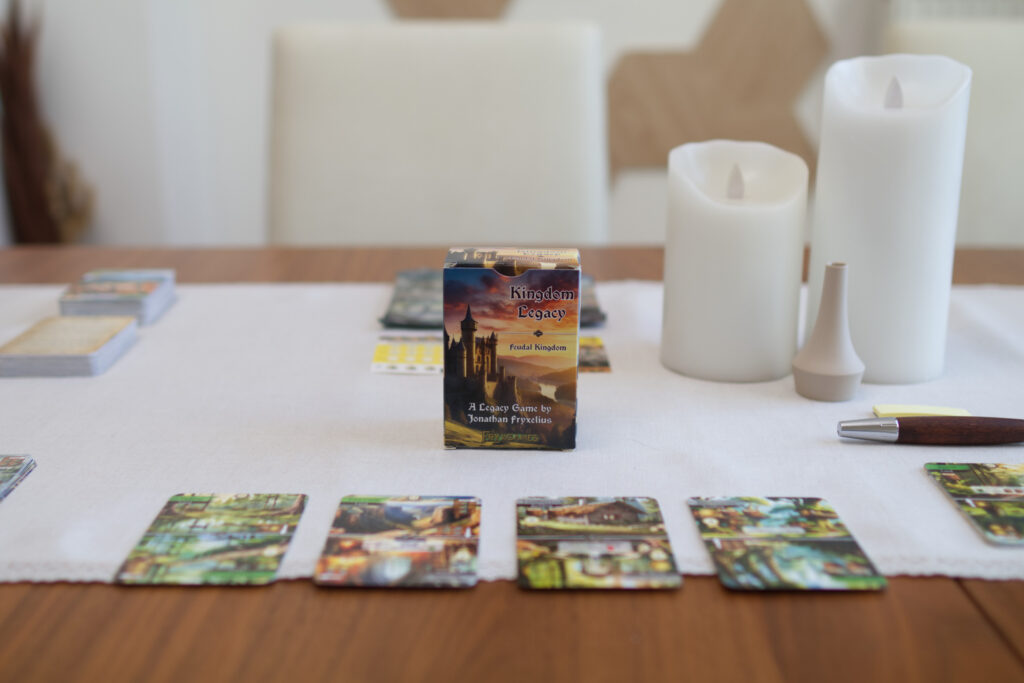
Setup
The base game of Kingdom Legacy comes in a small box that fits 140 cards, a folded sheet of rules, and two sheets of stickers. As the box says, this is a solo-only legacy game, so there will be stickering, writing on cards, and – as the rules funnily state – repurposing destroyed cards as toilette paper. Setup is pretty quick: take the cards labeled 1-10, shuffle them and use as your active deck. Set cards 11-70 aside as your deck of discovery, basically the game’s timer. Cards 71 and higher are set aside and some may or may not come into play depending on how you progress in the game. That’s it!
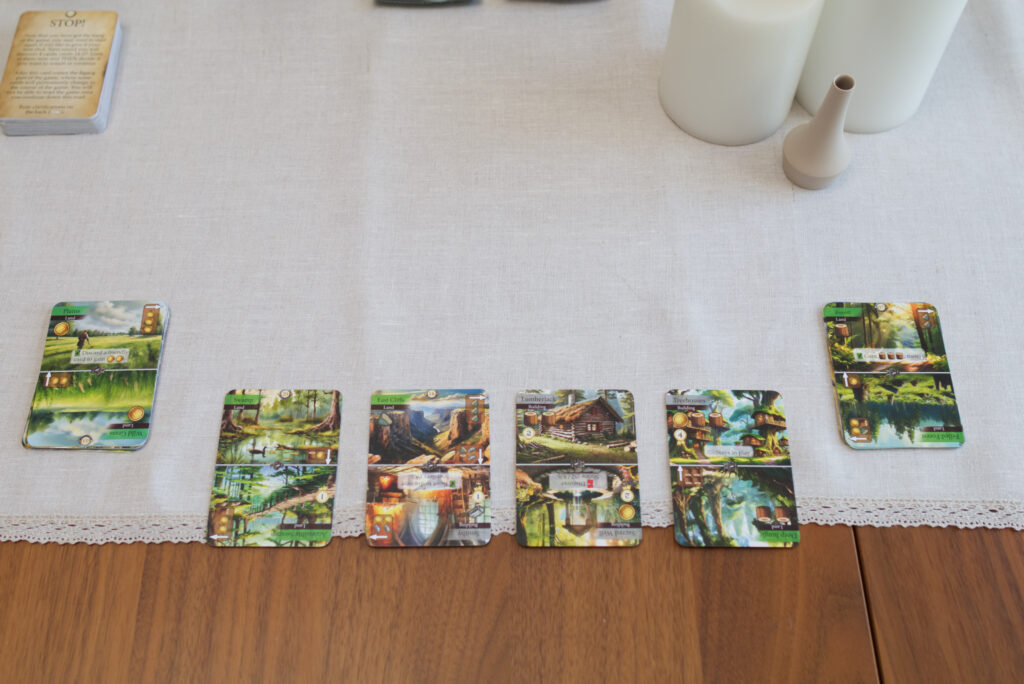
The Turn
On a turn, draw four cards from the deck and put them into play (=lay them out in front of you). You can keep drawing more cards (two at a time) unless a card specifically stops you from doing so. Each card represents a land in your kingdom (grass lands, swamp, forest, hills, …), person, event, building, or one of a number of other types. Most cards have some form of production meaning they can be discarded to generate one or more resources. Also pretty much all of them can be rotated and/or flipped to upgrade them. For example a grassland might turn into a corn field might turn into a barn if you invest money and time into it. A turn usually ends once you pay upgrade a single card. Everything not used for that goes into the discard pile as well unless it has the “stay in play” ability or is a “permanent” card.
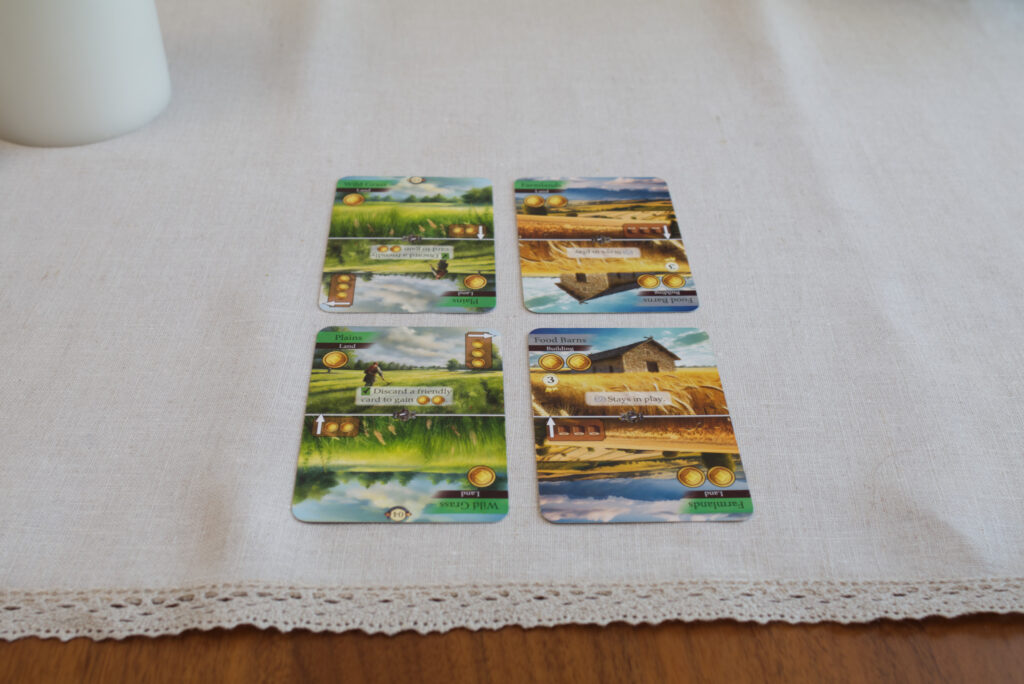
So you’re paying resources and flipping or rotating cards to increase your production. E.g. invest wood to turn hills into a mine that produces iron. At some point you will inevitably run out of cards to draw, which ends the round. Draw the top two cards from the discovery pile, add them to your active deck, shuffle, and you’re ready for the next round. This makes drawing additional cards on a given turn a necessary (to be able to pay for more expansive upgrades) but also a risky endeavour as that one wood you need might just not show up. At some point, there inevitably will be a noticeable sunken cost fallacy as one starts to think “I can’t give up now! Only one more stone and I can build that castle!”. But as you draw more and more cards, you are effectively reducing the number of turns you will have until the game ends – and – increase the chance a negative card might come into play and ruin your turn completely.
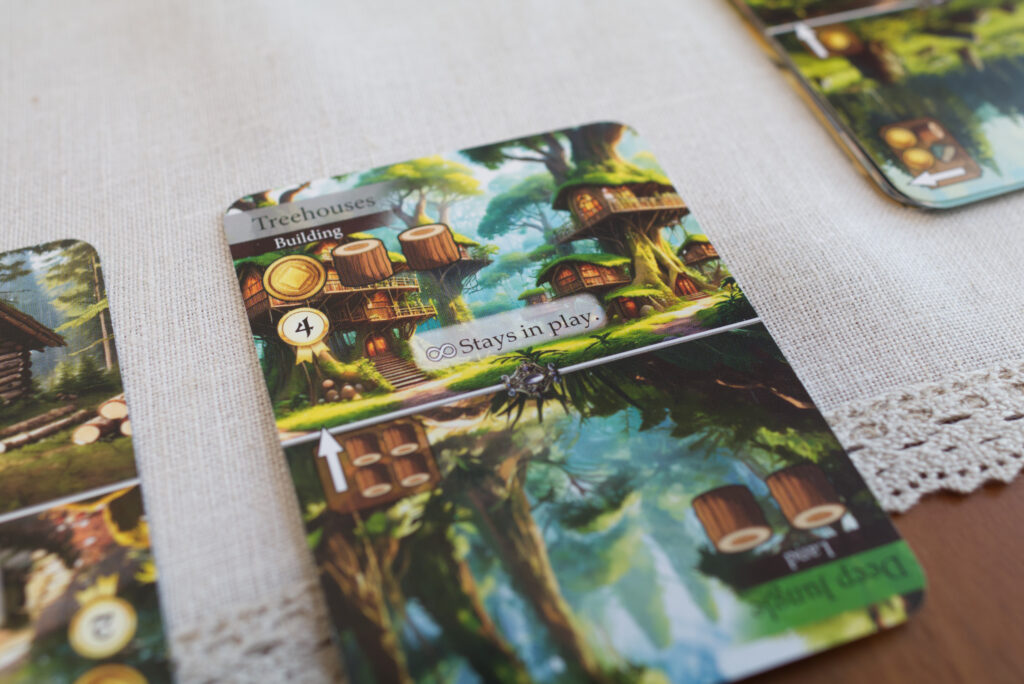
There are a couple additional mechanisms that are introduced over time such as enemies entering the deck for which you will have to find ways to neutralise or remove them, new rounds where the player will have to make a choice between adding card A or B to the deck (and removing the other from the game, never to have been used), long term projects to work on, etc. But the core always remains: how do you most efficiently upgrade cards to bolster your production and should you invest in one particular direction or in another? Do you increase your wood production or invest in your army. Cut down that forest completely or rather preserve it? Build up that tavern or rather a castle?
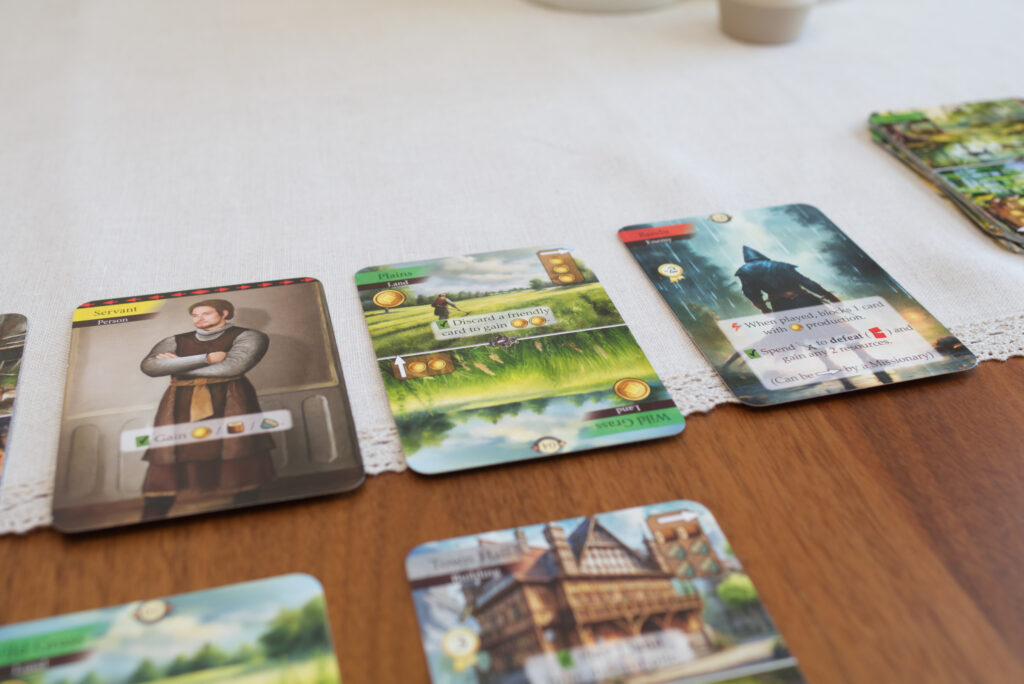
Game End
The game ends after the round that adds card 70 to your deck is over. Calculate the VP printed on the cards in your kingdom (higher upgraded ones of course bring more VP than ones that have only been upgraded once or none at all) and that’s it, your journey is over. With the unique code that’s printed on the inside of the box, you can submit your score. There are also three mini expansions in the box consisting of a single card each that lets you play four additional rounds per expansion under some special conditions. They are basically “range extenders” if you want to continue playing with your kingdom but they don’t add any new cards.
While your deck may start out small and therefore rounds are over quickly, later in the game your deck will easily consist of 60 or more cards. So rounds get longer, but also you will need to draw more cards each turn to be able to pay the high costs of more advanced upgrades. Can’t build a castle with just one stone, right? Overall, playtime is approx 3-4h, add to that about approx 45min for each of the mini expansions. So we are talking about a quite meaty solo experience for such a small box here.
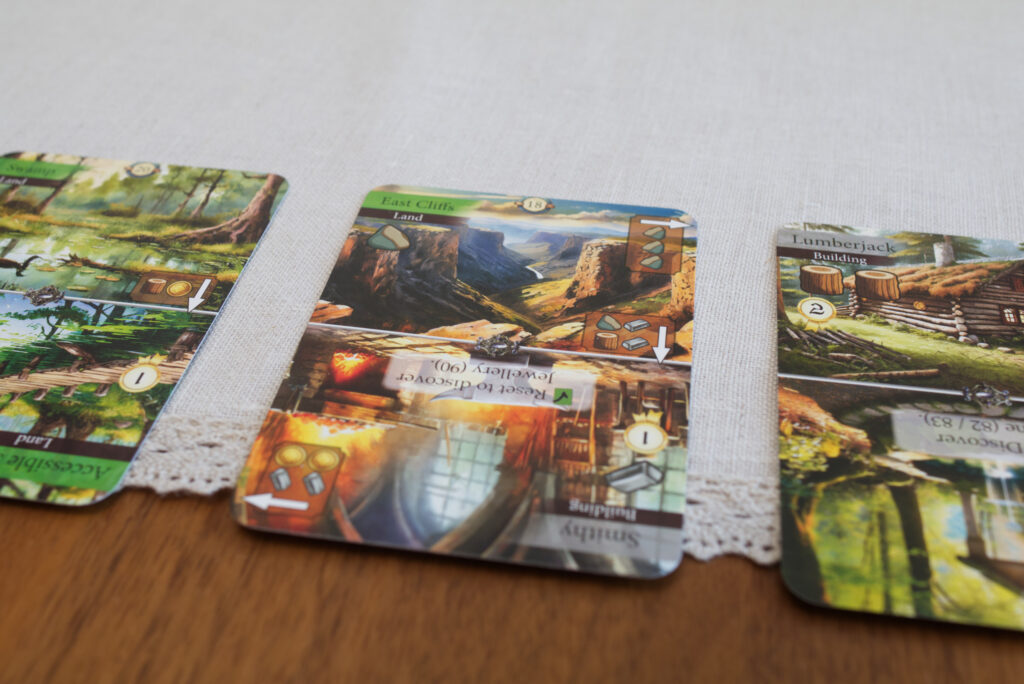
The Legacy Element
In contrast to games like Palm Island, Kingdom Legacy is designed to be played only once. If you want to have another go, you’re supposed to buy a new copy. Also unlike My City or Pandemic Legacy, you will not end up with a customised deck you can continue to play. With the low price of the game, that’s actually not as bad as a value proposition as it might sound. For comparison, it’s approx the price of an EXIT game and that has a shorter playtime than Kingdom Legacy.
The legacy aspect of Kingdom Legacy is two-fold. On the one hand, there are the physical aspects: the rules tell you “destroy” cards, write on them for various purposes, and comes with two sheets of stickers. A lot of the latter is to increase resource production of an individual card, so more like boosts and less consequential changes. As soon as the game leaves its initial tutorial phase, it will arbitrarily ask the player to sticker two cards, the only purposes of which seems to be to invalidate a copy from re-use/re-selling.
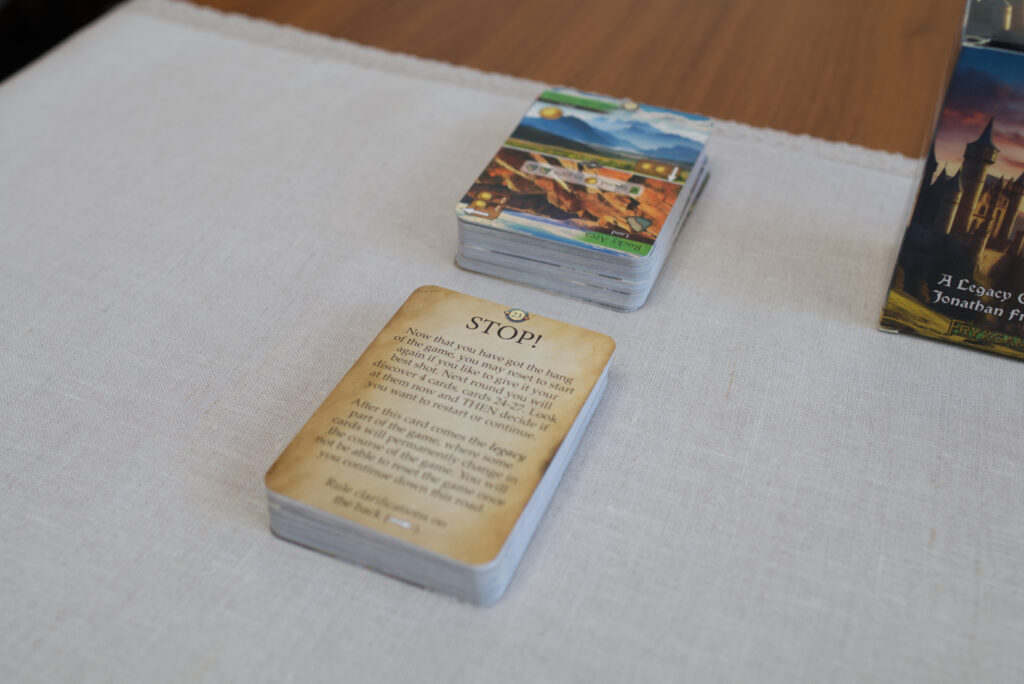
Any meaningful change of cards – as far as I have seen – was done using the rotate/flip mechanic. It’s not the depth of a choose-your-own-adventure book, but nonetheless it was nice to see the progression of the cards. E.g. using the effect of an upgraded card that then allows you to hire someone that can be upgraded themselves and bring new projects with them. Or exploring some landscape and that leading to new elements that extend your kingdom. In some plays, I deliberately set myself the goal that this time I wanted to see where maximising a particular card would lead me to. Or try to build that lighthouse. And there is great potential for such discovery: of the 70 cards that are set aside during setup, you will likely only see 15-20 in one play of the base game without the mini expansions. So the obvious question is: couldn’t this game have been designed in a way that doesn’t need stickers? Why put so much content in there that players won’t see on a single play?
There are multiple way to work around stickering: of course, one can use sleeves and then cut the sticker sheet into individual pieces and insert them into the sleeves as needed. At one point I was actually considering designing some custom 3D printed card holder with insertable upgrade tokens and was halfway done when I realised there is a way simpler solution: small post-it stickers. I already had some lying around that were 4x1cm and worked brilliantly here. Even shuffling wasn’t much of a problem using this method. On a single playthrough, only around 7-10 cards needed to be stickered this way and the rest could be done with some small tokens as trackers, so it’s not too bothersome.
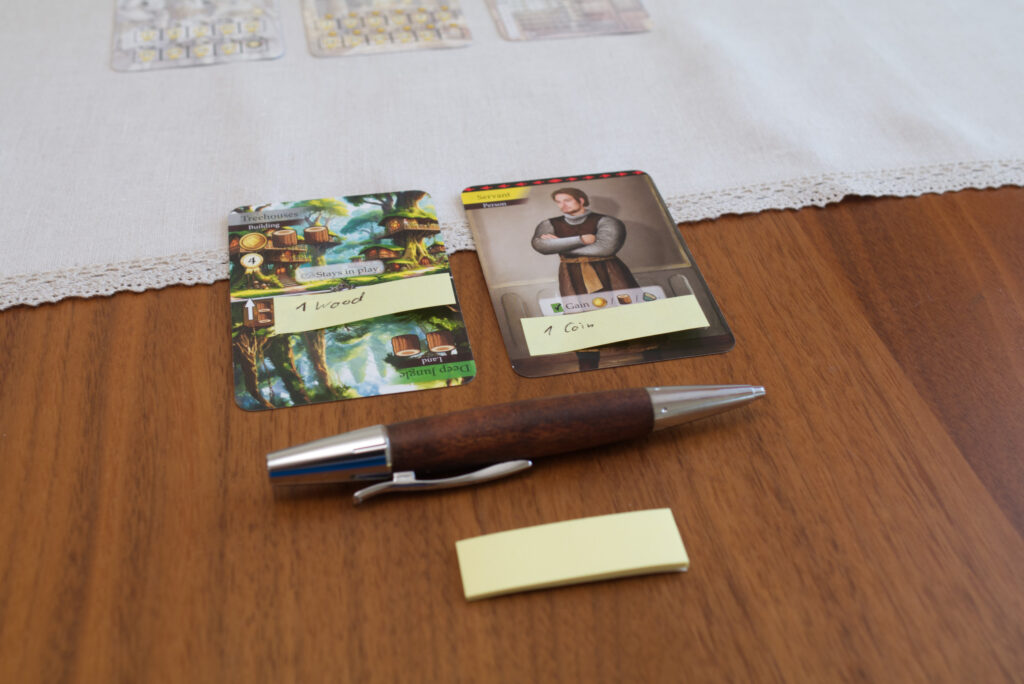
Separate Expansions
At the time of writing, two separate expansion booster packs exist that come with just shy of 30 cards and a sticker sheet each. Merchants adds four more rounds to your base game, similar to how the mini-expansions add a limited amount of extra time. Merchants focuses on offering the player new cards to buy by gathering larger amounts of resources but doesn’t add anything in the sense of narrative.
Adventures on the other hand adds three rounds in each of which the player can pick a challenge: bad thing X will make your life harder and you can fulfil the challenge by achieving Y a certain number of times. Both expansions have in common that they don’t manipulate any of the base game content. I had hoped they would add to the “narrative” of the existing cards and that would have been the one situation where I could have seen stickers really making sense, i.e. adding new abilities to evolve on to existing cards. But alas, this is not so.
So while it’s nice to have more content, I played each once and don’t plan to return to them, rather focusing on exploring all branches in the base game. There is a new, bigger expansion announced and I hope that will build upon the strength of the base game: make you feel like your kingdom is evolving based on your decisions.
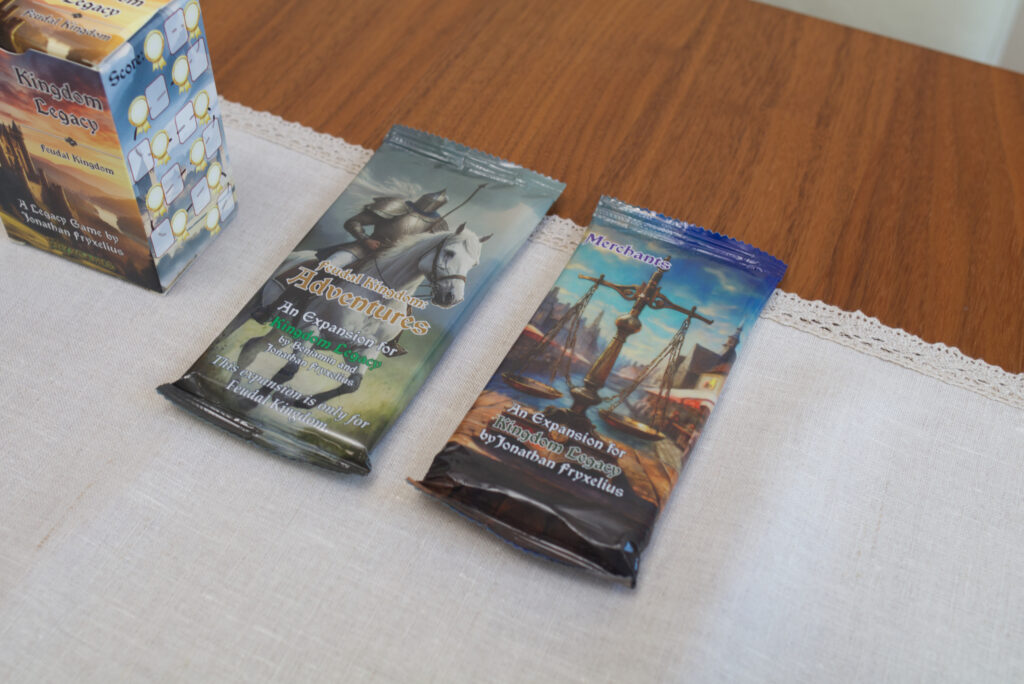
Update Jan 2025: I’ve put out a review for Kingdom Legacy: Distant Lands, the first big (160 cards) expansion for Kingdom Legacy: Feudal Kingdoms. If you like the base game, you’ll definitely should pick up that one as well.
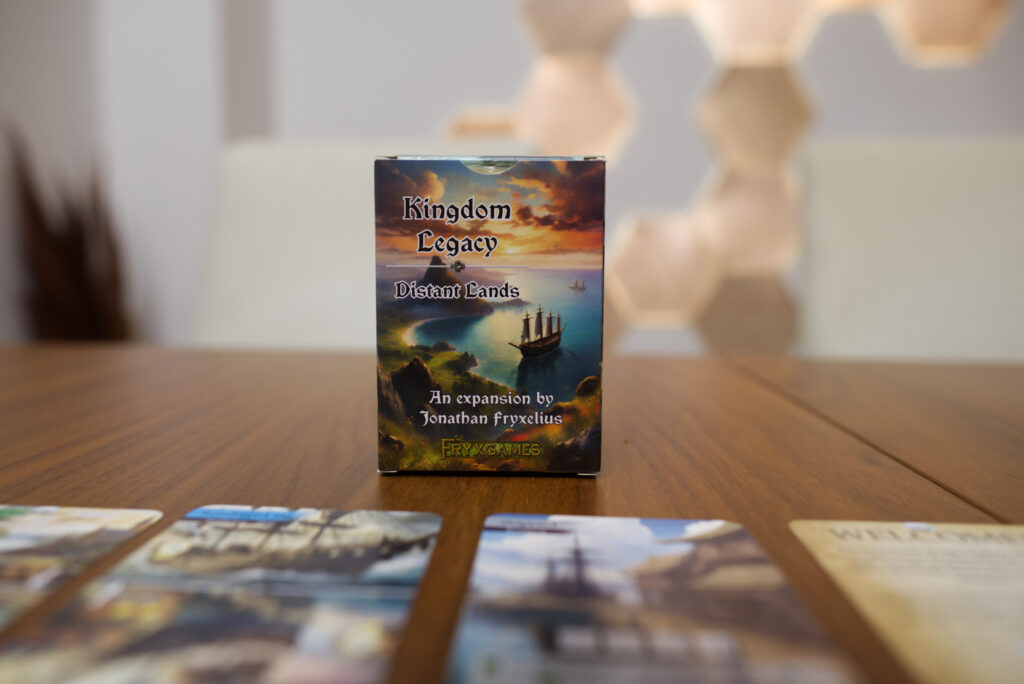
AI Art Direction
When I first saw Kingdom Legacy‘s artwork, I was blown away. Why would someone invest so much money in doing hundreds of individual illustrations for a small, inconspicuous card game? I mean there are 140 cards, most of them with four illustrations on them for the four different stages of upgrading, and there aren’t that many cards that appear more than one or two times in the whole deck. “It must have cost a fortune to do this” was my initial thought.
However, there was something off about the box art. The colours looked too intense, the humans in the game too much like a photo. Turns out all the art was generated using AI-tooling. From what I read on BGG, Jonathan the designer (and also self-titled art director for lack of a better term) tried to do what he could to use tooling that actually has been trained on source material where the artists got paid for it. Still, the use of AI-generated art in board gaming is a controversial topic where – as far as I can tell – most people prefer non-AI artwork and supporting human artists.
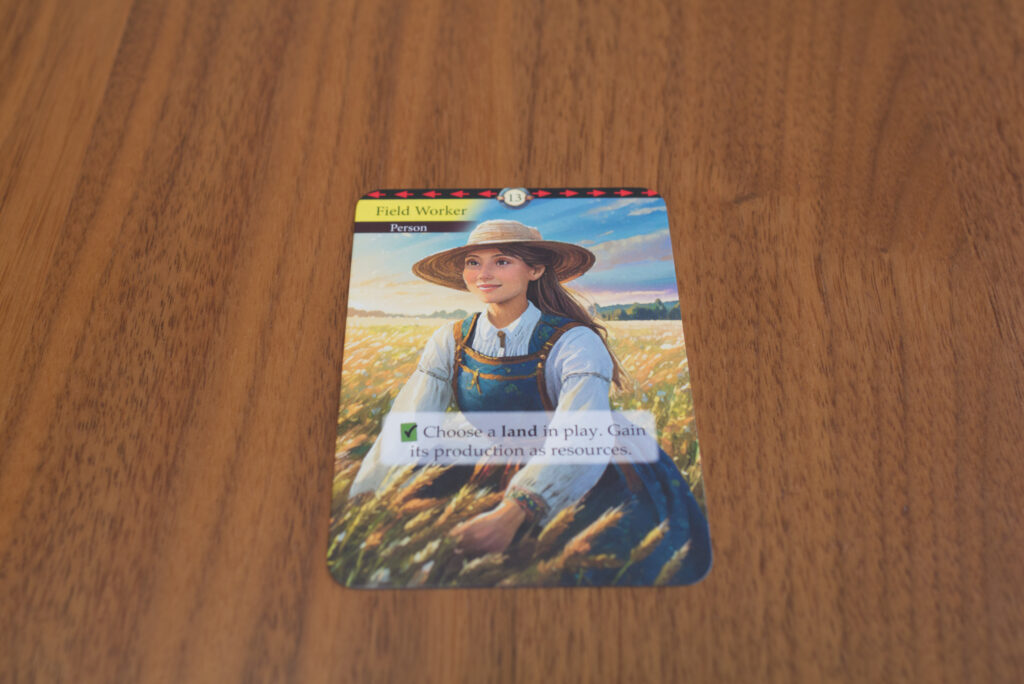
For me, this is the first case I’m actually getting confronted with this topic in a game I now own. Well, the results look pretty stunning and having this vast amount of different illustrations helps convey the feeling of a buzzing kingdom. On the other hand especially the human characters have a strange quality to them that puts them firmly in uncanny value territory. I also had a few cases where I failed to notice production icons because the illustration in the background was so colourful and had so many details that I didn’t see the sword icon in front of it.
Money no object, I would definitely have preferred an Andrew Bosley or Ian O’Toole to design this and the results would probably have been better as well. However, the number of illustrations that would be needed makes this simply infeasible. So the choice could have been between a) generating images via AI, b) licensing existing images (resulting in an incoherent style and high licensing costs), or c) do the game without illustrations on cards but keep the cards rather abstract. From that perspective, the discussion gets more interesting: do we prefer hiring a human and get like 5-10 different illustrations or use AI and get 300+ for the same game? In the case of Kingdom Legacy, seeing your kingdom evolve is part of the core experience …
I don’t want to turn this review into an AI or non-AI opinion piece, because that discussion is complex and many people have already written way better argued pieces than I could on that topic. Short story: in this particular case, I’m personally okay with it, but I still prefer the work of human artists. The graphics do look great, but it is a bit over the top and in a few cases hurts readability.
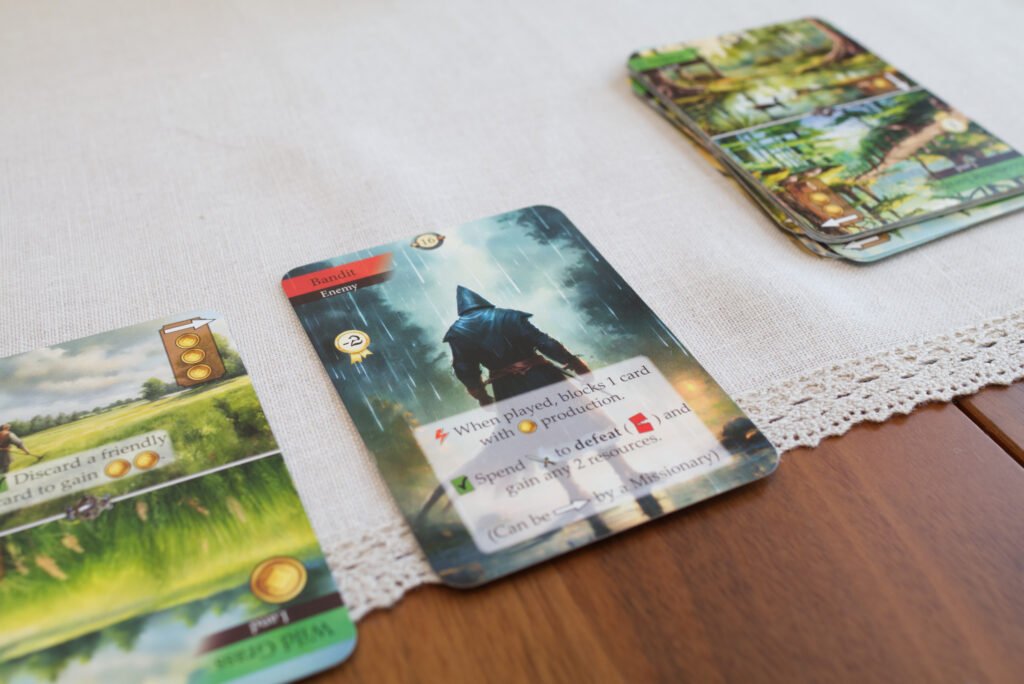
Conclusion
It’s quite remarkable that of all the games I bought at SPIEL Essen 2024, this is the first game for me to write about. It was the one that had the lowest barrier of entry in terms of rules and had the biggest pull on me to explore the system. That’s quite the achievement for a small 15€ box! I had a great time figuring out if I should first increase my production of coins or rather focus on getting more stone more quickly, seeing where upgrading a particular card multiple times would lead me to, and so on. I’m now multiple plays in and still enjoy making the most out of my hand and upgrading cards to later be happy about those advancements when I see them again in the next round.
Kingdom Legacy reminded me of Palm Island, but turned up to eleven. In Palm Island, players kept the whole small deck in their hand, tucked in cards horizontally as resources and used those to also rotate and flip cards to upgrade. But it never led to something satisfying for me because of its small scope and it basically being just a beat your own score game. Kingdom Legacy definitely solves the first part. Even after multiple plays, I’ve likely only seen half of the cards in the range of 71-140. Unfortunately, Kingdom Legacy didn’t solve the second part though. While it has a great first (build something up) and second (defend against negative cards) act, the third act fizzles out a bit. You’re playing for 3-4h and in the end it’s no satisfying “you win” but just “well, now count together your score and throw the game away”. The journey was still enjoyable, but the destination left me wanting for a more satisfying conclusion. There are elements in the game that could easily have been turned into hard goals/loss-conditions, but the one-time-play nature unfortunately rendered that idea obsolete.
Which brings me to my second major critique: why the one-time play design? The stickering is just for production increase and it’s not like a Pandemic Legacy or something where next time you see a stickered card you’ll think “oh my god, remember what happened there?”. Even if the stickering would have stayed in there, at least the game could have been turned into something where the player now owns a customised deck and there is some mechanism like the mini-expansions that lets the player continue to play with their personal deck indefinitely. One can do that, but it doesn’t really make sense because it renders the “get a high score” goal of the game invalid. So the physical legacy element isn’t really used to the strength of the medium and just gives the weird aftertaste of a sales strategy: have them sticker something and make them buy more copies. Which is a shame, because without it, I’d probably bought 3-4 copies already just to gift to friends because I liked my play-experience that much!
There is also the issue of playing rules incorrectly and only halfway through noticing it, rendering your score even more meaningless. The two-page rule sheet is quite good, but there are still things that can be misinterpreted like for me the exact consequences of the “stays in play” ability (they only stay in play until the end of the round AND they leave play when used). It wasn’t anything that hurt my enjoyment of the game, but with a game that could be played multiple times, I would have just shrugged and restarted the game. That’s not really possible here if played as intended. In a similar vain, I don’t like that there are some negative cards in there that the player has no agency about. If they come up, they hurt you, and they will do that repeatedly every round. I can see why they are in the game from a mechanical view (=to make it risky to draw more additional cards on any one turn) but I much more enjoyed those negative cards where I had at least a slim chance of actually doing something about them.
Kingdom Legacy is at its best when it tells a story without text. There isn’t a written narrative in there like the quests in a Sleeping Gods, but the pictures and names tell a story themselves. It’s immensely satisfying when you finally manage to pay the high cost of a final upgrade step for a card and that perhaps allows you to then pull out a new card from that 71-140 stack and add it to your deck. The base game does this very well, I wished there would have been more of that in expansions.
So to sum up: definite buying recommendation from me! If you like solo games that are a bit meatier when it comes to play time, you’ll have a great time with this. Just use some way to work around the stickering and you’ll have a great little re-playable game. My recommendation would also be to set yourself some hard goal with each play, like fulfilling one of the multi-round projects in the game or explore a certain card to the full extend of its upgrades and ignoring the VP scoring. Personally, I found this much more satisfying. To me, Kingdom Legacy feels like a game that didn’t realise what its strong points truly are. An experiment that is already good and highly enjoyable but needs just one more iteration to be absolutely brilliant. For the new big expansion, my hope is that a) it integrates more tightly with the narrative of the base game content than the existing expansions and b) adds some form of hard win/loss conditions and replayability. But whatever it will be, it’s already an auto-buy for me. Despite all the points of critique I have, I enjoyed this system very much and am looking forward to more!
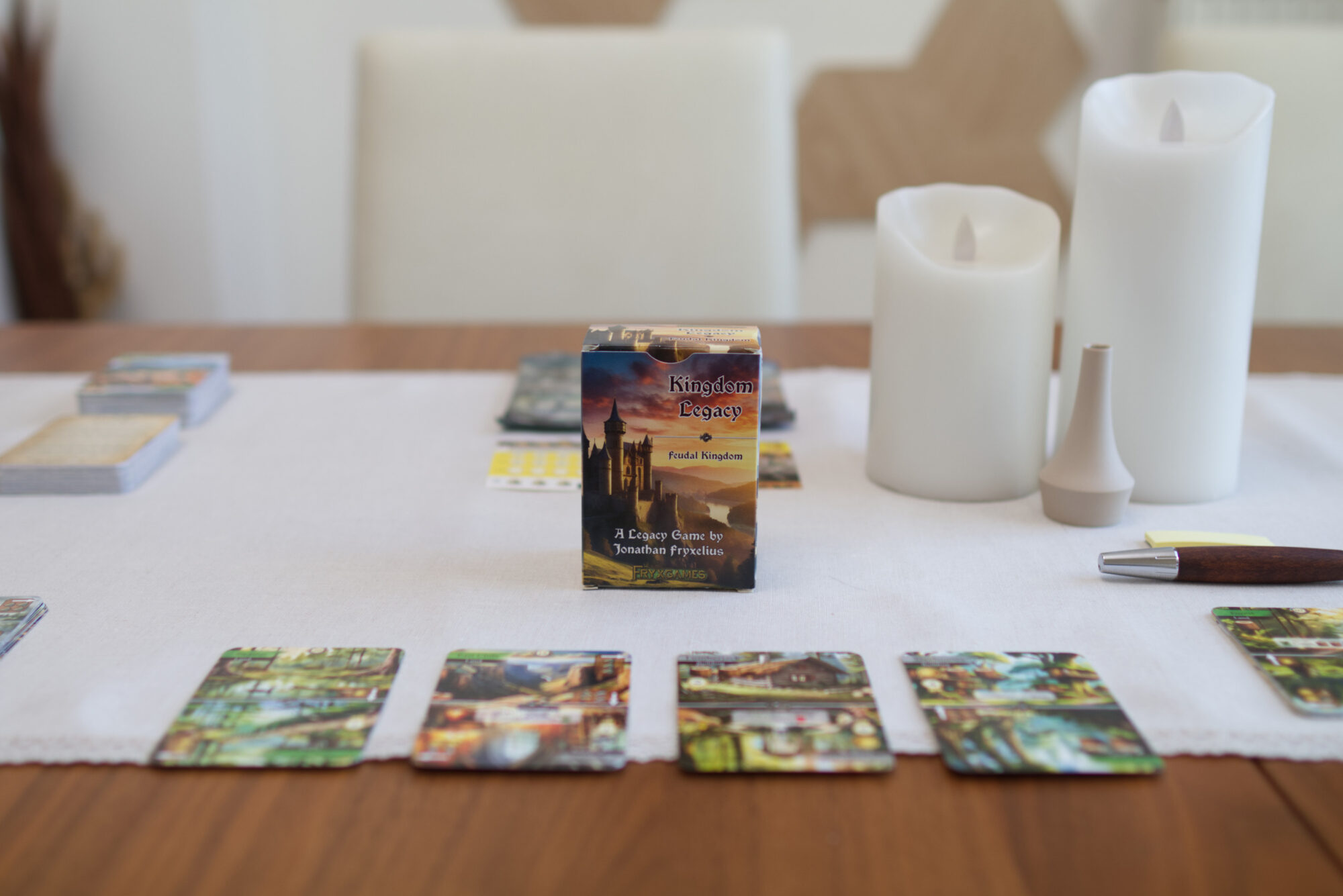
Thanks for the review! Bought the game after reading your review (and others) and so far, I’m loving the game.
That‘s great, thanks for the feedback. By the way: the next big (160 cards) expansion “Distant Lands” has just been released. So far I have only seen it available on the publisher’s website though.